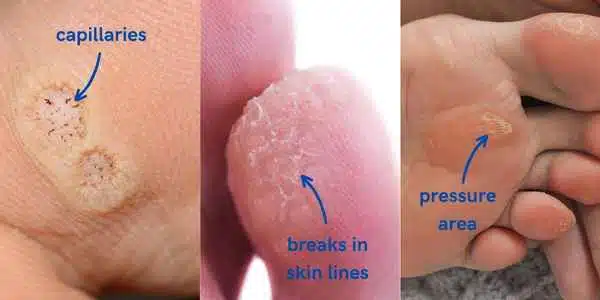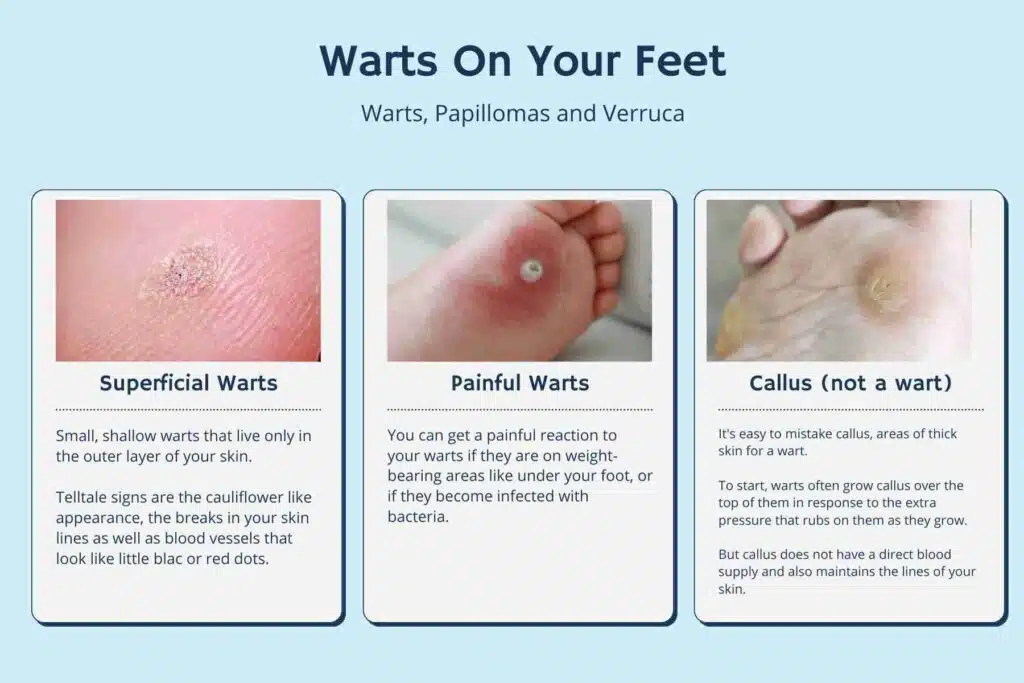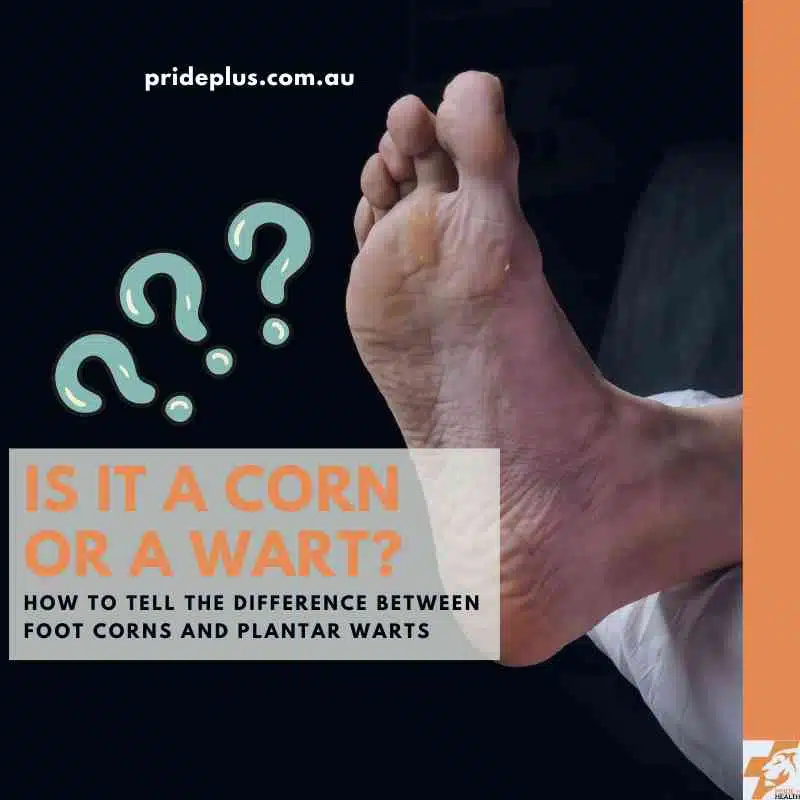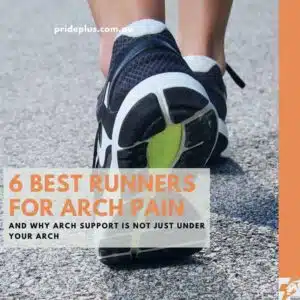Have you ever wondered what is the difference between a foot corn and plantar wart?
You know, those built-up lesions of hard skin that cause that feeling of discomfort on your feet? Did you do some google research and found out that you only have a few days to live and start panicking.
Well, rest assured I’m here to tell you that there is no need to stress, one stop at your podiatrist and you’re on your way to fixing your problem.
But before you come in and visit us, you might want to learn a bit more about those pesky little lesions. Let’s dive into what the difference is between a foot corn and a plantar wart and what they have in common too
But first, what is a foot corn?
In our podiatry terms they’re known as a heloma durum, but we usually just say a foot corn to keep it nice and simple.
They’re caused by pressure, friction or rubbing on your skin. This rubbing triggers your skin to thicken for protection in response. Initially, this hard skin is known as a callus.
If this pressure or friction is not addressed over time then a corn will form.
Foot corns feel hard, bumpy and can look a bit flakey at times too. They’re tender and painful when pressed but usually you won’t notice them when there is no pressure on them.
I like to think of corn as a diamond in which the wider part of the diamond sits outside the skin and the rest of it is underneath the layer of the skin, where the pointy end feels like a pin-like sensation when pressure is applied.
And, a plantar wart is…
A wart can grow anywhere on your body, but a plantar wart or verruca pedis is a viral lesion that grows on your feet.
All warts are caused by a virus called the human papillomavirus (HPV). This virus is contagious to touch and if it gets into your skin causes a mutation of your skin cells which grow in a new, cauliflower like state.
Plantar warts do look similar to a foot corn, however on closer inspection there are a few differences.
Let’s take a peek.

Difference between a foot corn and a plantar wart
Let’s start with their appearances.
Foot corns are small, hard bits of your own skin growing as a natural response to friction and pressure. As such, they grow exactly like the rest of your skin, with natural skin lines present throughout.
But plantar warts are mutations. The virus causes your skin growth to be rushed and disrupted. You won’t see your skin lines (think fingerprint lines) stay normal through a wart. They’ll also trick your body into feeding them more by encouraging new blood vessel formation. As you look at a wart these new vessels will look like little black dots about the size of a pinhead.
The size of your foot lesion can also be a giveaway.
While a plantar wart can be very small (<2mm in diameter) they can also spread to cover the entire surface of the foot. A foot corn is only going to be small.
Another difference between a foot corn and a plantar wart is where they grow. Plantar warts can grow anywhere on your feet, but foot corns require friction and pressure to develop. This means they only grow where the ground, your shoes or toes rub up against each other.
Now you know the difference between a foot corn and a plantar wart, let me show you what you can do about them.

How to treat foot corns and plantar warts
Treating a corn on the foot and plantar warts are a similar process.
We first start by removing the excess overlying hard skin (callus) that has formed over or around your lesion. Then, for a corn, we enucleate it, a painless process where we take out the lesion leaving you with healthy intact skin,
That is as hard as it’s going to get. We have a conversation about how we can prevent your corn from coming back. Remember how we discussed pressure?
Let’s get into it further… What kind of pressure is causing a corn to form?
Is it tight shoes, the way your feet move when you walk or the shape of any lumps and bumps that have grown on your feet?
Whatever your cause, we’ll help you make some changes to prevent or delay your foot corn from coming back. This might involve recommending new shoes or using custom foot orthotics to deflect pressure.
Treating plantar warts
In the past you might have had an encounter with warts on your hands and had to freeze them at your doctors.
Rest assured that treating your plantar warts won’t be painful like that.
The aim of treating warts is to get the body to recognise there is a viral invader tricking your immune system. In the clinic, after we debride your wart, (take off the layer of hard skin) we then decide what type of medicament will work best for you to get your immune system responding to resolve your wart.
There are lots of different options for this but three stand out as the most effective:
- Salicylic Acid (a natural acid produced by your sweat glands)
- Silver Nitrate Solution (a medicament that’s been used for hundreds of years)
- Vitamin A a retinoid that’s taken orally for healthy skin and eyes but is effective topically for wart treatment)
To achieve complete wart resolution it depends on a few factors. The main one being how effective is your immune system at fighting off the viral invader. If your overall health is top notch the resolution time is shorter vs. if you’re run down or struggling with chronic disease or on other medications it can take longer.
Around 2 – 3 treatments in the clinic is usually enough for wart resolution however, stubborn, large warts combined with a low immune system can take much longer.
Before you go
Now you know the difference between a foot corn and plantar wart you’re probably wanting your lesion treated. You can do that by visiting our podiatrists in clinic and booking your session together now.
You can also learn more about corns between toes and how to treat warts on the feet at home too.
About the Author

Pascoe Vale podiatrist Zainab Alnajar doesn’t want you to freak out and worry if you don’t know the difference between a foot corn and plantar wart. She wants to help you.
References
- Difference between foot corns and callus. PridePlus Health.
- Differential diagnosis of plantar wart from corn, callus and healed wart with the aid of dermoscopy. British Journal of Dermatology. (2008)
- Salicylic Acid (Topical Route) Proper Use. Mayo Clinic. (2022)
- Corns. StatPearls. (2022)




